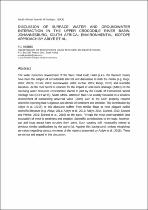 ResearchSpace
ResearchSpace
Discussion of surface water and groundwater interaction in the Upper Crocodile River Basin, Johannesburg, South Africa: environmental isotope approach by Abiye et al.
JavaScript is disabled for your browser. Some features of this site may not work without it.
- ResearchSpace
- →
- Research Publications/Outputs
- →
- Journal Articles
- →
- View Item
| dc.contributor.author |
Hobbs, PJ

|
|
| dc.date.accessioned | 2017-02-03T08:32:24Z | |
| dc.date.available | 2017-02-03T08:32:24Z | |
| dc.date.issued | 2015-12 | |
| dc.identifier.citation | Hobbs, P.J. 2015. Discussion of surface water and groundwater interaction in the Upper Crocodile River Basin, Johannesburg, South Africa: environmental isotope approach by Abiye et al. South African Journal of Geology, 118(4), pp 511-515 | en_US |
| dc.identifier.issn | 1012-0750 | |
| dc.identifier.uri | http://sajg.geoscienceworld.org/content/118/4/514 | |
| dc.identifier.uri | http://hdl.handle.net/10204/8921 | |
| dc.description | Copyright: 2016 Geological Society of South Africa | en_US |
| dc.description.abstract | The water resources downstream of the West Rand Gold Field (a.k.a. the Western Basin) have been the subject of considerable interest and discussion in both the media (e.g. Béga, 2010; 2012a; 2012b; 2013; Groenewald, 2010; Jordan, 2015; Kings, 2015) and scientific literature. At the root hereof is concern for the impact of acid mine drainage (AMD) on the receiving water resources environment shared in part by the Cradle of Humankind World Heritage Site (COH WHS), South Africa. Attention that is so acutely focussed on a sensitive environment of outstanding universal value (OUV) such as the COH property requires scientific reporting that is rigorous and devoid of sentiment and emotion. The contribution by Abiye et al. (2015) to this discourse suffers from similar flaws as have plagued earlier scientific literature (e.g. Abiye, 2011; Abiye et al., 2011; Abiye, 2014; Durand, 2012; Durand and Peinke, 2010; Durand et al., 2010) on the topic. Perhaps the most understandable (and excusable) of these is sentiment and emotion. Scientific contributions to the topic, however, can and must attract keen scrutiny from peers. Such scrutiny will necessarily extend to previous similar publications by the author(s). Against this background, serious misgivings are raised regarding various elements of the material presented by Abiye et al. (2015). These are set out and argued in this discussion. | en_US |
| dc.language.iso | en | en_US |
| dc.publisher | Geological Society of South Africa | en_US |
| dc.relation.ispartofseries | Wokflow;17523 | |
| dc.subject | West Rand Gold Field water resources | en_US |
| dc.subject | Acid mine drainage | en_US |
| dc.subject | AMD | en_US |
| dc.subject | Environmental isotope | en_US |
| dc.title | Discussion of surface water and groundwater interaction in the Upper Crocodile River Basin, Johannesburg, South Africa: environmental isotope approach by Abiye et al. | en_US |
| dc.type | Article | en_US |
| dc.identifier.apacitation | Hobbs, P. (2015). Discussion of surface water and groundwater interaction in the Upper Crocodile River Basin, Johannesburg, South Africa: environmental isotope approach by Abiye et al. http://hdl.handle.net/10204/8921 | en_ZA |
| dc.identifier.chicagocitation | Hobbs, PJ "Discussion of surface water and groundwater interaction in the Upper Crocodile River Basin, Johannesburg, South Africa: environmental isotope approach by Abiye et al." (2015) http://hdl.handle.net/10204/8921 | en_ZA |
| dc.identifier.vancouvercitation | Hobbs P. Discussion of surface water and groundwater interaction in the Upper Crocodile River Basin, Johannesburg, South Africa: environmental isotope approach by Abiye et al. 2015; http://hdl.handle.net/10204/8921. | en_ZA |
| dc.identifier.ris | TY - Article AU - Hobbs, PJ AB - The water resources downstream of the West Rand Gold Field (a.k.a. the Western Basin) have been the subject of considerable interest and discussion in both the media (e.g. Béga, 2010; 2012a; 2012b; 2013; Groenewald, 2010; Jordan, 2015; Kings, 2015) and scientific literature. At the root hereof is concern for the impact of acid mine drainage (AMD) on the receiving water resources environment shared in part by the Cradle of Humankind World Heritage Site (COH WHS), South Africa. Attention that is so acutely focussed on a sensitive environment of outstanding universal value (OUV) such as the COH property requires scientific reporting that is rigorous and devoid of sentiment and emotion. The contribution by Abiye et al. (2015) to this discourse suffers from similar flaws as have plagued earlier scientific literature (e.g. Abiye, 2011; Abiye et al., 2011; Abiye, 2014; Durand, 2012; Durand and Peinke, 2010; Durand et al., 2010) on the topic. Perhaps the most understandable (and excusable) of these is sentiment and emotion. Scientific contributions to the topic, however, can and must attract keen scrutiny from peers. Such scrutiny will necessarily extend to previous similar publications by the author(s). Against this background, serious misgivings are raised regarding various elements of the material presented by Abiye et al. (2015). These are set out and argued in this discussion. DA - 2015-12 DB - ResearchSpace DP - CSIR KW - West Rand Gold Field water resources KW - Acid mine drainage KW - AMD KW - Environmental isotope LK - https://researchspace.csir.co.za PY - 2015 SM - 1012-0750 T1 - Discussion of surface water and groundwater interaction in the Upper Crocodile River Basin, Johannesburg, South Africa: environmental isotope approach by Abiye et al TI - Discussion of surface water and groundwater interaction in the Upper Crocodile River Basin, Johannesburg, South Africa: environmental isotope approach by Abiye et al UR - http://hdl.handle.net/10204/8921 ER - | en_ZA |





